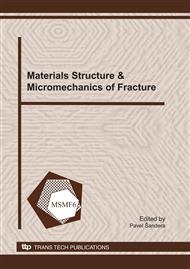[1]
J.V. Sharp: Phil. Mag. Vol. 16 (1967) p.77.
Google Scholar
[2]
D.J. Edwards, B.N. Singh and J.B. Bikde-Sorensen: J. Nucl. Mat. Vol. 342 (2005) p.164.
Google Scholar
[3]
Z. Jiao, J.T. Busby and G.S. Was: J. Nucl. Mater. Vol. 361 (2007) p.218.
Google Scholar
[4]
T.S. Byun, N. Hashimoto and K. Farrell: J. Nucl. Mat. Vol. 351 (2006) p.303.
Google Scholar
[5]
P. Lukas, M. Knesnil and J. Krejci: Phys. Stat. Sol. Vol. 27 (1968) p.545.
Google Scholar
[6]
J.M. Finney and C. Laird: Phil. Mag. Vol. 31 (1975) p.339.
Google Scholar
[7]
Ch. Blochwitz and U. Veit: Crystal Res. & Technol. Vol. 17 (1982) p.529.
Google Scholar
[8]
L.C. Lim and R. Raj: Acta Metall. Vol. 32 (1984) p.1183.
Google Scholar
[9]
J. Man, K. Obrtlik, Ch. Blochwitz and J. Polak: Acta Mat. Vol. 50 (2002) p.3767.
Google Scholar
[10]
C. Wejdemann and O.B. Pedersen: Mat. Sci. Eng. A Vol. 387 (2004) p.556.
Google Scholar
[11]
E.H. Lee, M.H. Yoo, T.S. Byun, J.D. Hunn, K. Farrell and L.K. Mansur: Acta. Mater. Vol. 49 (2001) p.3277.
Google Scholar
[12]
V. Gerold: Scripta Metall. Vol. 16 (1982) p.405.
Google Scholar
[13]
K.V. Rasmussen and O.B. Pedersen: Acta Met. Vol. 14 (1980) p.1467.
Google Scholar
[14]
J.D. Eshelby: Proc. R. Soc. Lond. A Vol. 241 (1957) p.76.
Google Scholar
[15]
E.A. Repetto and M. Ortiz: Acta Mater. Vol. 45 (1997) p.2577.
Google Scholar
[16]
M. Sauzay and P. Gilormini: Th. Appl. Fract. Mech. Vol. 38 (2002) p.53.
Google Scholar
[17]
M. Sauzay, Ch. Caës, M. Mottot and Ch. Robertson: J. Phys. IV Vol. 106 (2003) p.99.
Google Scholar
[18]
W. Liu, M. Bayerlein, H. Mughrabi, A. Day and P.N. Quested: Acta Metall. Mater. Vol. 40 (1992) p.1763.
Google Scholar
[19]
L.C. Lim and R. Raj: Acta Metall. Vol. 32 (1984) p.1177.
Google Scholar
[20]
E.P. Simonen and S.M. Bruemmer, in: 7th International Symposium on Environmental Degradation of Materials in Nuclear Power Systems – Water Reactors, edited by A.R. McIllree and S.M. Bruemmer National Association of Corrosion Engineers, Houston, TX Vol. 2 (1995).
DOI: 10.1002/9781118787618.ch105
Google Scholar
[21]
A. Toivonen, U. Ehrnsten, W. Karlsen, P. Aaltonen, J. -P. Massoud and J. -M. Boursier, in: 12th Int. Symposium on Environmental Degradation of Materials in Nuclear Power Systems/Water Reactors, edited by T.R. Allen, P.J. King and L. Nelson The Minerals, Metals & Materials Society (2005).
DOI: 10.1002/9781118456835.ch22
Google Scholar
[22]
S.M. Bruemmer, E.P. Simonen, P.M. Scott, P.L. Andresen, G.S. Was and J.L. Nelson: J. Nucl. Mat. Vol. 274 (1999) p.299.
Google Scholar
[23]
H. Margolin and M.S. Stanescu: Acta Met. Vol. 23 (1975) p.1411.
Google Scholar
[24]
P. Neumann: Scripta Met. Mater. Vol. 26 (1992) p.1535.
Google Scholar
[25]
O. Diard, S. Leclercq, G. Rousselier and G. Cailletaud: Int. J. Plast. Vol. 21 (2005) p.691.
Google Scholar
[26]
A.N. Stroh: Proc. Roy. Soc. Vol. 223 (1954) p.404.
Google Scholar
[27]
K. Tanaka and T. Mura: J. appl. Mech. Vol. 103 (1981) p.97.
Google Scholar
[28]
T. Tabata, H. Fujita, M. -A. Hiraoka, and K. Onishi: Phil. Mag. A Vol. 47 (1983) p.841.
Google Scholar
[29]
M. Sauzay, K. Bavard and W. Karlsen: J. Nucl. Mater. available online (2010).
Google Scholar
[30]
P. Evrard and M. Sauzay: J. Nucl. Mater. Accepted for publication (2010).
Google Scholar
[31]
M. Sauzay and Th. Jourdan: Int. J. Fract. Vol. 141 (2006) p.431.
Google Scholar
[32]
M. Savoie, PhD, Ecole des Mines de Saint-Etienne France.
Google Scholar
[33]
A. Weidner, R. Beyer, C. Blochwitz, C. Holste, A. Schwab and W. Tirschler: Mater. Sci. Eng. A Vol. 435-436 (2006) p.540.
DOI: 10.1016/j.msea.2006.07.039
Google Scholar
[34]
H. Mughrabi, R. Wang, K. Differt, U. Essmann, in: Fatigue mechanisms: advances in quantitative measurement of physical damage, edited by J. Lankford, D. L. Davidson, W. L. Morris and R. P. Wei ASTM STP 811 (1983), p.5.
DOI: 10.1520/stp811-eb
Google Scholar
[35]
J. Polak and M. Sauzay: Mat. Sci. Eng. A Vol. 500 (2009) p.122.
Google Scholar


